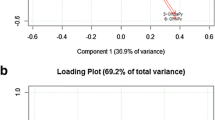Abstract
Objectives: Internal polycyclic aromatic hydrocarbon (PAH) exposure is usually studied by determining 1-hydroxypyrene in urine. In many studies, increased urinary levels of 1-hydroxypyrene have been found in smokers compared with non-smokers. The disadvantage of this procedure, however, is that it is based on only one substance. Therefore, in our study, urine specimens from smokers and non-smokers were tested for four monohydroxylated phenanthrenes in addition to 1-hydroxypyrene. Subjects and methods: Spot urine samples from 288 non-smokers and 100 smokers were analysed for 1-, 2-, 3- and 4-hydroxyphenanthrene and 1-hydroxypyrene by a very sensitive high performance liquid chromatography (HPLC) method with fluorescence detection. The detection limit of the method is 5 ng metabolite/l urine. The data were calculated on a creatinine basis (ng/g creatinine). Results: Highly significant differences and dose-response relationships with regard to cigarettes smoked per day were found for 2-, 3- and 4-hydroxyphenanthrene and 1-hydroxypyrene, but not for 1-hydroxyphenanthrene. When the ratio of the sum of hydroxyphenanthrenes to 1-hydroxypyrene, and the ratio of 1- and 2-/3- and 4-hydroxyphenanthrene were taken into consideration, significant negative dose-response relationships to the numbers of cigarettes smoked per day, were found. Conclusion: 1-Hydroxypyrene as well as 2-, 3- and 4-monohydroxylated phenanthrenes in urine may be used as parameters to detect PAH exposure from cigarette smoking. Moreover, 3,4-oxidation of phenanthrenes was found to be enhanced in smokers, with a significant dose-response relationship. This phenomenon is thought to be caused by an induction of the CYP 1A2 (or CYP 3A4) monooxygenase system in smokers. Therefore, it may be recommended that monohydroxylated phenanthrenes be analysed in order to assess the balance between the PAH-metabolising cytochrome isoforms, and the activity or induction of cytochrome P450 isoforms, respectively.
Similar content being viewed by others
Author information
Authors and Affiliations
Additional information
Received: 12 May 2000 / Accepted: 1 November 2000
Rights and permissions
About this article
Cite this article
Heudorf, U., Angerer, J. Urinary monohydroxylated phenanthrenes and hydroxypyrene – the effects of smoking habits and changes induced by smoking on monooxygenase-mediated metabolism. Int Arch Occup Environ Health 74, 177–183 (2001). https://doi.org/10.1007/s004200000215
Issue Date:
DOI: https://doi.org/10.1007/s004200000215




